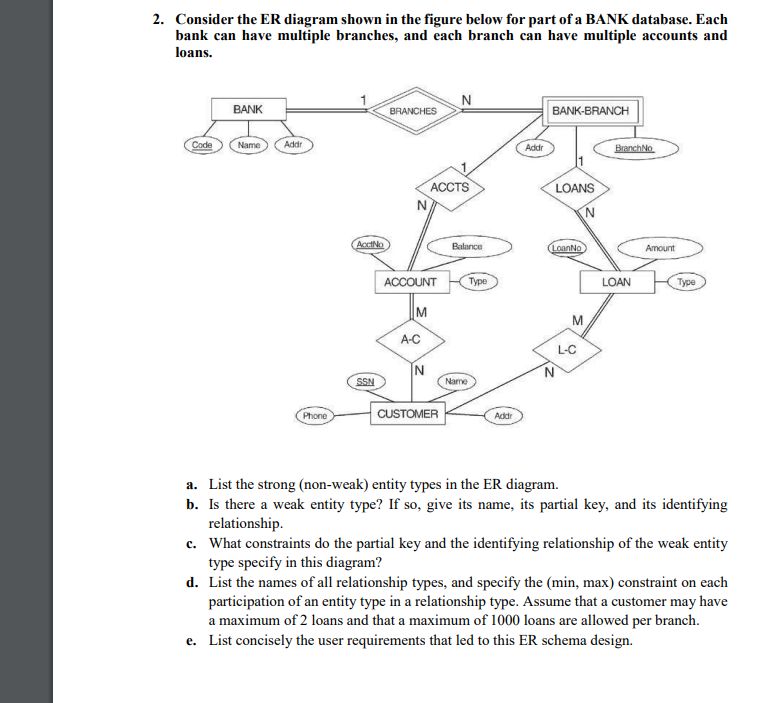Consider the ER diagram shown in the figure below for part of a BANK database. Each bank can have multiple branches, and each branch can have multiple accounts and loans. a. List t... Consider the ER diagram shown in the figure below for part of a BANK database. Each bank can have multiple branches, and each branch can have multiple accounts and loans. a. List the strong (non-weak) entity types in the ER diagram. b. Is there a weak entity type? If so, give its name, its partial key, and its identifying relationship. c. What constraints do the partial key and the identifying relationship of the weak entity type specify in this diagram? d. List the names of all relationship types, and specify the (min, max) constraint on each participation of an entity type in a relationship type. Assume that a customer may have a maximum of 2 loans and that a maximum of 1000 loans are allowed per branch. e. List concisely the user requirements that led to this ER schema design.

Understand the Problem
The question is asking to analyze an Entity-Relationship (ER) diagram for a bank database. It requires identifying strong and weak entity types, constraints related to keys, names of relationship types with their constraints, and user requirements for the schema design.
Answer
a. BANK, BRANCH, ACCOUNT, LOAN, CUSTOMER. b. Yes, BANK-BRANCH, BranchNo, BRANCHES. c. Unique BranchNo in context of a bank. d. BRANCHES (1, N), ACCTS (1, N), LOANS (1, N). e. Banks have branches; branches handle accounts/loans; customers max 2 loans; max 1000 loans/branch.
a. Strong entity types: BANK, BRANCH, ACCOUNT, LOAN, CUSTOMER. b. Yes, weak entity type: BANK-BRANCH, partial key: BranchNo, identifying relationship: BRANCHES. c. The partial key uniquely identifies branches in the context of a bank, meaning each branch must have a unique BranchNo within its bank. d. Relationship types: BRANCHES (BANK, BRANCH), ACCTS (BRANCH, ACCOUNT), LOANS (BRANCH, LOAN), A-C (ACCOUNT, CUSTOMER), L-C (LOAN, CUSTOMER). Constraints: BRANCHES (1, N), ACCTS (1, N), LOANS (1, N); bank can have multiple branches, branches have multiple accounts and loans. e. Requirements: Banks have branches, branches manage accounts and loans, customers have accounts and up to two loans, up to 1000 loans per branch.
Answer for screen readers
a. Strong entity types: BANK, BRANCH, ACCOUNT, LOAN, CUSTOMER. b. Yes, weak entity type: BANK-BRANCH, partial key: BranchNo, identifying relationship: BRANCHES. c. The partial key uniquely identifies branches in the context of a bank, meaning each branch must have a unique BranchNo within its bank. d. Relationship types: BRANCHES (BANK, BRANCH), ACCTS (BRANCH, ACCOUNT), LOANS (BRANCH, LOAN), A-C (ACCOUNT, CUSTOMER), L-C (LOAN, CUSTOMER). Constraints: BRANCHES (1, N), ACCTS (1, N), LOANS (1, N); bank can have multiple branches, branches have multiple accounts and loans. e. Requirements: Banks have branches, branches manage accounts and loans, customers have accounts and up to two loans, up to 1000 loans per branch.
More Information
Entity-Relationship diagrams visually represent the structure of a database. Strong entity types have their own primary keys, while weak entities depend on another entity. Constraints help define the relationships more specifically.
Tips
Avoid assuming all entities with multiple relationships are weak; look for absence of their own key.
Sources
- Solved Consider the ER diagram - Chegg - chegg.com
- Consider The ER Diagram in Figure 7 - Scribd - scribd.com
AI-generated content may contain errors. Please verify critical information